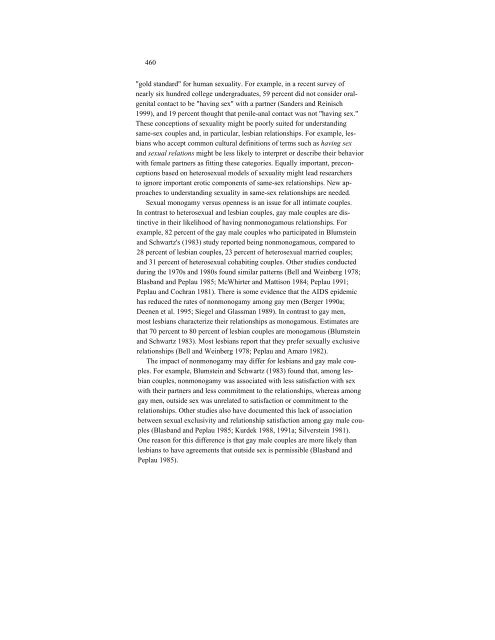17 The Close Relationships of Lesbians, Gay Men, and Bisexuals
17 The Close Relationships of Lesbians, Gay Men, and Bisexuals
17 The Close Relationships of Lesbians, Gay Men, and Bisexuals
You also want an ePaper? Increase the reach of your titles
YUMPU automatically turns print PDFs into web optimized ePapers that Google loves.
460<br />
"gold st<strong>and</strong>ard" for human sexuality. For example, in a recent survey <strong>of</strong><br />
nearly six hundred college undergraduates, 59 percent did not consider oral-<br />
genital contact to be "having sex" with a partner (S<strong>and</strong>ers <strong>and</strong> Reinisch<br />
1999), <strong>and</strong> 19 percent thought that penile-anal contact was not "having sex."<br />
<strong>The</strong>se conceptions <strong>of</strong> sexuality might be poorly suited for underst<strong>and</strong>ing<br />
same-sex couples <strong>and</strong>, in particular, lesbian relationships. For example, les-<br />
bians who accept common cultural definitions <strong>of</strong> terms such as having sex<br />
<strong>and</strong> sexual relations might be less likely to interpret or describe their behavior<br />
with female partners as fitting these categories. Equally important, precon-<br />
ceptions based on heterosexual models <strong>of</strong> sexuality might lead researchers<br />
to ignore important erotic components <strong>of</strong> same-sex relationships. New ap-<br />
proaches to underst<strong>and</strong>ing sexuality in same-sex relationships are needed.<br />
Sexual monogamy versus openness is an issue for all intimate couples.<br />
In contrast to heterosexual <strong>and</strong> lesbian couples, gay male couples are dis-<br />
tinctive in their likelihood <strong>of</strong> having nonmonogamous relationships. For<br />
example, 82 percent <strong>of</strong> the gay male couples who participated in Blumstein<br />
<strong>and</strong> Schwartz's (1983) study reported being nonmonogamous, compared to<br />
28 percent <strong>of</strong> lesbian couples, 23 percent <strong>of</strong> heterosexual married couples;<br />
<strong>and</strong> 31 percent <strong>of</strong> heterosexual cohabiting couples. Other studies conducted<br />
during the 1970s <strong>and</strong> 1980s found similar patterns (Bell <strong>and</strong> Weinberg 1978;<br />
Blasb<strong>and</strong> <strong>and</strong> Peplau 1985; McWhirter <strong>and</strong> Mattison 1984; Peplau 1991;<br />
Peplau <strong>and</strong> Cochran 1981). <strong>The</strong>re is some evidence that the AIDS epidemic<br />
has reduced the rates <strong>of</strong> nonmonogamy among gay men (Berger 1990a;<br />
Deenen et al. 1995; Siegel <strong>and</strong> Glassman 1989). In contrast to gay men,<br />
most lesbians characterize their relationships as monogamous. Estimates are<br />
that 70 percent to 80 percent <strong>of</strong> lesbian couples are monogamous (Blumstein<br />
<strong>and</strong> Schwartz 1983). Most lesbians report that they prefer sexually exclusive<br />
relationships (Bell <strong>and</strong> Weinberg 1978; Peplau <strong>and</strong> Amaro 1982).<br />
<strong>The</strong> impact <strong>of</strong> nonmonogamy may differ for lesbians <strong>and</strong> gay male cou-<br />
ples. For example, Blumstein <strong>and</strong> Schwartz (1983) found that, among les-<br />
bian couples, nonmonogamy was associated with less satisfaction with sex<br />
with their partners <strong>and</strong> less commitment to the relationships, whereas among<br />
gay men, outside sex was unrelated to satisfaction or commitment to the<br />
relationships. Other studies also have documented this lack <strong>of</strong> association<br />
between sexual exclusivity <strong>and</strong> relationship satisfaction among gay male cou-<br />
ples (Blasb<strong>and</strong> <strong>and</strong> Peplau 1985; Kurdek 1988, 1991a; Silverstein 1981).<br />
One reason for this difference is that gay male couples are more likely than<br />
lesbians to have agreements that outside sex is permissible (Blasb<strong>and</strong> <strong>and</strong><br />
Peplau 1985).
















